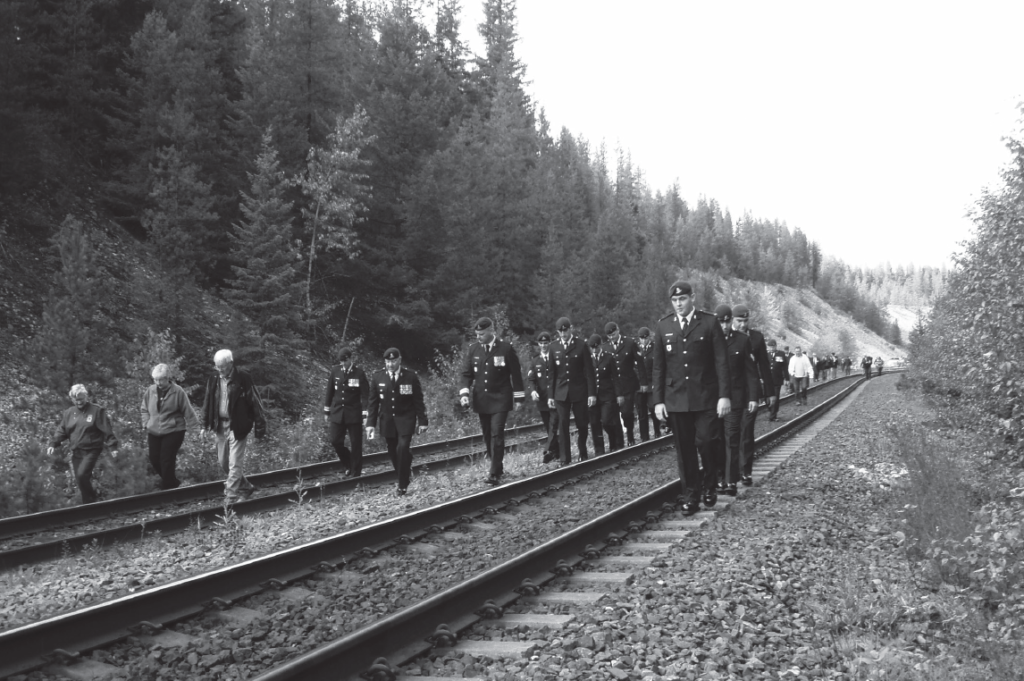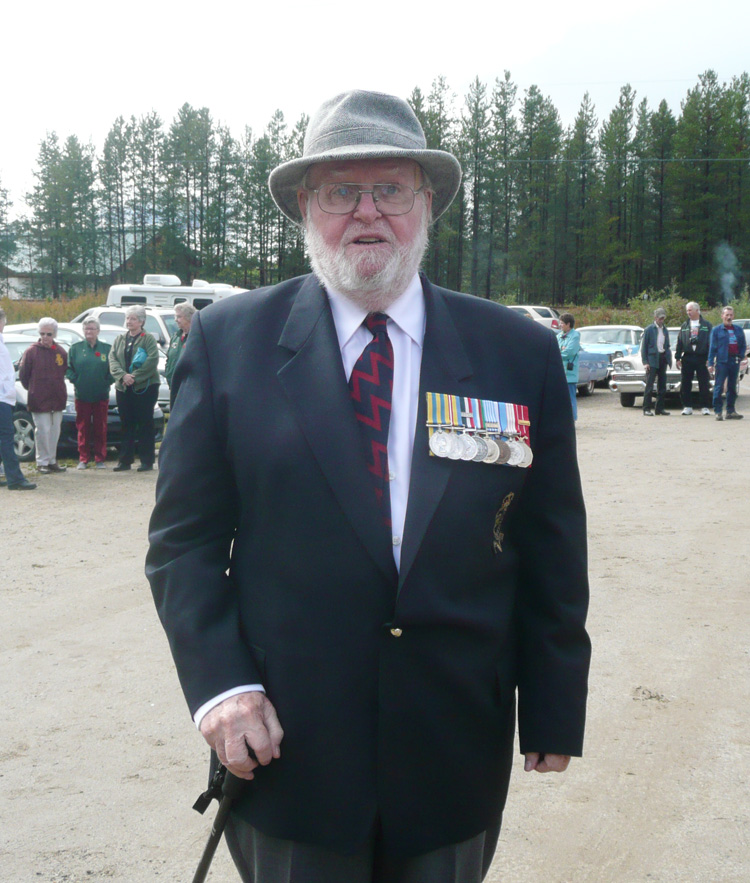By Joseph Nusse
Published in 2010
“It was a long, cold day. It was wet snow and we were all cold and wet.”
James Henderson was 21 when he found himself bound for Korea. The military was a way of life for him and his family.
“My father was a soldier in World War II. I joined the militia when I was 13. I was already in the army when the Korean War broke out.”
Henderson was the only soldier on the train crash 60 years ago near Canoe River who was present at the Canoe River Train Crash memorial held on Saturday in Vale-mount. Other Korean War veterans who were not on the train also came from as far as Ontario to pay their respects to fellow fallen comrades.

Henderson remembers the scene vividly. “I was in the rear coach. When the train hit, there was not a lot of bumping in the back car. After that though, it was a very long day.”
While his own coach did not even leave the track, where the two trains collided was a mess of shredded metal, splintered wooden coaches, bodies, and dozens of injured men needing help.
“I knew some of them,” he says. “I was an officer, they were all privates, but I knew some by name.”
Lial McIvor from Bonocourt Alberta was already in Korea when it happened. He says that he and the men around him knew some of the men killed and injured in the wreck. He and several other members of the Korean Veterans Association enjoyed lunch and conversations of memories over beer. Younger active soldiers of The Royal Canadian Horse and Garrison Artillery out of Petawawa Ontario also took place in the event, first marching in formation with veterans and cadets down 5th Avenue, then standing attention as dignitaries, relatives and cadets laid twenty one wreaths, one for each of the seventeen soldiers killed, as well as the four CN staff.
Enid Stables from Edmonton marched for her husband, Korean Veteran John Sterling Stables. Myrna Skinner, also from Edmonton also marched for her husband Hecktor Skinner. Both husbands are now in care at hospitals, but Stables and Skinner say that if it were possible, they would have attended the event.
“John did two tours, three years, in Korea. He would sometimes talk about memories, usually not related to the war. For instance, one night he was in his sleeping bag and he woke up one morning to a rat having babes right beside his head,” Stables laughs.
“There were also some lighter tales such as sneaking some whiskey into camp after time off in Ja-pan.”
“It was hard walking for them knowing that they couldn’t be here,” Skinner adds.
Dong Han served in the Korean Army from 1958 to 1961. He immigrated to Canada and worked for SaskTel for many years. He now lives in Jasper where he helps his wife run an ice cream shop. He is an active member of the Jasper Legion.
“We Koreans honour their sacrifice in fighting tyranny and aggression. Korea today is a vibrant democracy with a robust economy and we are promoting peace around the world,” he says in a speech.
“We are proud of what we have managed to accomplish and we thank all of you. Please accept our deepest gratitude and re-spect. Kamsamnida!”
John Kolanchey is a Korean Veteran who was part of the 2nd Battalion of Princess Patricia’s Canadian Light Infantry who received the Presidential Unit Citation and the Distinguished Unit Citation (now Presidential Unit Citation (US)) from the President of the United States to recognize its stand at the battle of Kapyong during the Korean War in April 1951. The Pa-tricias, together with the 3rd Battalion of the Royal Australian Regiment, which re-ceived the same honour, held the line in an attack by Chinese troops.
“The Chinese general promised Mao that they would take Seoul Labour Day. It was not a big battle, but it was one of the most important battles of the war,” says Kolanchey.
He recalls vividly the scene of the battle.
“It was night but everything was light up like day. We ran out of ammunition, water and food. The planes had to drop supplies for us. We were dug into position but it was hand to hand kind of Mountain warfare.”
Kolanchey says that even after the battle, the mountain warfare was a hard reality of their position.
“We would stay 23-24 days without coming down. We were usually supplied by Koreans carrying backpacks of supplies. They were Korean conscripts, usually older.”
Kolanchey is one of many Korean veterans who have taken advantage of a revisitation offer by the Korean government.
“Six years ago I went back. My wife wanted to know what it was like when I was there. We had to go to a museum,” he laughs. “When I was there, all three bridges into Seoul were blown up. When I returned there were many bridges with four lanes going both ways and a train on top. Canadians are still well-liked in Korea.”
Later at the very scene of the crash, Henderson recalls his experience that cold day sixty years ago.
“The troop train was wooden coaches, they splintered on impact and caused a lot of the injuries to troops. The east-bound passenger train was steal coaches. Only the men in the Engine died. One officer was very enthusiastically taking photos on the scene. I remember wondering if he should be helping instead. Today those photos are priceless.”

Henderson also recalls the ensuing enquiries.
“If it had happened a little bit sooner, the trains would have seen each other on a straight stretch. If it had happened a little bit later, it would have been on the Canoe River bridge and been a lot worse. There were other questions. For instance, the first aid boxes in the coaches were empty, even though they were behind a ‘break glass in case of emergency’ case.”
A legal case brought forward by crown prosecution sought to lay blame and manslaughter charges on a switchman from Red Pass. A young attorney named John Diefenbaker successfully cleared the man of the charges. The mountain on which the crash occurred is now named after him, but for his role as Prime Minister of Canada between 1957 and 1963.



